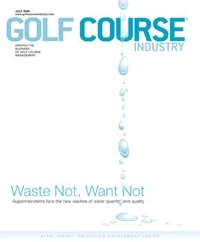I got the call in the middle of last month. Boy was Morris Johnson excited. The director of golf course operations at River Oaks Country Club in Houston rarely gets worked up about new golf course maintenance products, but this was an exception.
River Oaks is in the midst of a course renovation, and Johnson was elated about the installation of a new bunker liner – the likes of which he and his colleagues in Texas haven’t seen before. Reportedly, the liner lasts longer than the others on the market and seals better, keeping the sand cleaner longer.
As an editor, I’m lucky enough to tour the manufacturing facilities of many suppliers that serve the industry and learn about a plethora of advancements in technologies that help superintendents do their jobs better and more efficiently. It’s amazing to see all the brainpower, planning and execution that go into the development of various high-quality products, from equipment to pesticides to irrigation systems.
However, editors are less likely to hear about an innovative product that’s the brainchild of a superintendent. That’s what’s so interesting about Kevin Clark, the guy who ignited Johnson’s excitement.
Clark, an assistant superintendent at Lantana Golf Club in Texas, is proof that necessity is the mother of invention. Lantana is a Jay and Carter Morrish design that features high, steep-sloped bunkers. The natural and synthetic liners in the bunkers (halfway through construction, the team switched from natural liners to synthetic ones) lasted only 18 months before they disintegrated into dust in the sand. It required 200 man-hours to pump water out of all the bunkers and return them to playable condition.
The Lantana crew tried every bunker liner – even various combinations – on the market and weren’t happy with any of them because none provided a long-term solution. Clark wanted to seal the bunker and keep the sand from contamination for a long time. With a little luck and a little skill, Clark came up with a better idea.
A box was sprayed with the Rhino liner material used on truck beds, and he filled it with dirt and kept it outside the office for a while to see how the liner material would wear. It seemed to work, so eventually the Rhino liner material was sprayed on top of geotextile material in a bunker to see how it would hold up in a golf application. There was just one problem: The surface was too slippery, and the sand wouldn’t stick to the steep faces. To solve the problem, Clark glued polypropylene fibers, similar to artificial turf, on top of the Rhino liner material. It worked. Clark invented a bunker liner to fit the needs of Lantana.
The liner eliminates the need for gravel, Clark says. It was such a good idea, 12 other courses in Texas used the liner in test bunkers, and River Oaks is installing it in all its bunkers.
Clark has one patent on the bunker liner and another one pending. He’s also in the midst of sealing a deal with a distributor that has a 14-state territory. Word is spreading in Texas and beyond. Clark received a call from someone in Charlotte, N.C., and architects are telling people on the East Coast.
Clark’s bunker liner has been successful enough that he’ll be leaving Lantana at the end of this month to sell his product full time, something he never thought he’d be doing at this stage of his career.
It sounds like Clark’s product will be good for the industry and great for him. And I’m sure Johnson won’t be the only superintendent excited about the bunker liner, which just might bring a smile to your face – if it hasn’t already – when you discuss the topic next time. GCI

Explore the July 2008 Issue
Check out more from this issue and find your next story to read.
Latest from Golf Course Industry
- Editor’s notebook: Green Start Academy 2024
- USGA focuses on inclusion, sustainability in 2024
- Greens with Envy 65: Carolina on our mind
- Five Iron Golf expands into Minnesota
- Global sports group 54 invests in Turfgrass
- Hawaii's Mauna Kea Golf Course announces reopening
- Georgia GCSA honors superintendent of the year
- Reel Turf Techs: Alex Tessman





